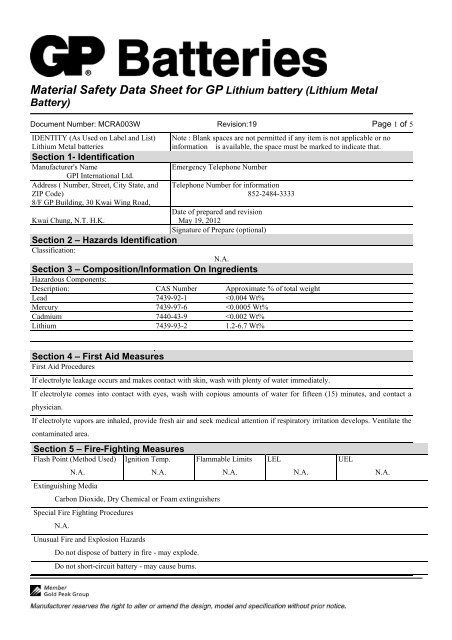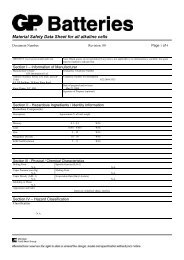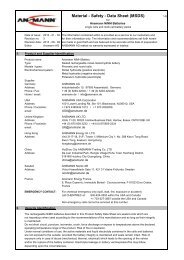Material Safety Data Sheet for GP Lithium battery (Lithium Metal
Material Safety Data Sheet for GP Lithium battery (Lithium Metal
Material Safety Data Sheet for GP Lithium battery (Lithium Metal
Create successful ePaper yourself
Turn your PDF publications into a flip-book with our unique Google optimized e-Paper software.
<strong>Material</strong> <strong>Safety</strong> <strong>Data</strong> <strong>Sheet</strong> <strong>for</strong> <strong>GP</strong> <strong>Lithium</strong> <strong>battery</strong> (<strong>Lithium</strong> <strong>Metal</strong><br />
Battery)<br />
Document Number: MCRA003W Revision:19 Page 1 of 5<br />
IDENTITY (As Used on Label and List)<br />
<strong>Lithium</strong> <strong>Metal</strong> batteries<br />
Section 1- Identification<br />
Manufacturer's Name<br />
<strong>GP</strong>I International Ltd.<br />
Address ( Number, Street, City State, and<br />
ZIP Code)<br />
8/F <strong>GP</strong> Building, 30 Kwai Wing Road,<br />
Kwai Chung, N.T. H.K.<br />
Section 2 – Hazards Identification<br />
Classification:<br />
Note : Blank spaces are not permitted if any item is not applicable or no<br />
in<strong>for</strong>mation is available, the space must be marked to indicate that.<br />
Emergency Telephone Number<br />
Telephone Number <strong>for</strong> in<strong>for</strong>mation<br />
852-2484-3333<br />
Date of prepared and revision<br />
May 19, 2012<br />
Signature of Prepare (optional)<br />
N.A.<br />
Section 3 – Composition/In<strong>for</strong>mation On Ingredients<br />
Hazardous Components:<br />
Description: CAS Number Approximate % of total weight<br />
Lead 7439-92-1
<strong>Material</strong> <strong>Safety</strong> <strong>Data</strong> <strong>Sheet</strong> <strong>for</strong> <strong>GP</strong> <strong>Lithium</strong> <strong>battery</strong> (<strong>Lithium</strong> <strong>Metal</strong><br />
Battery)<br />
Document Number: MCRA003W Revision:19 Page 2 of 5<br />
Section 6 – Accidental Release Measures<br />
Steps to Be Taken in Case <strong>Material</strong> is Released or Spilled<br />
Batteries that are leakage should be handled with rubber gloves.<br />
Avoid direct contact with electrolyte.<br />
Wear protective clothing and a positive pressure Self-Contained Breathing Apparatus (SCBA).<br />
Section 7 – Handling and Storage<br />
Safe handling and storage advice<br />
Batteries should be handled and stored carefully to avoid short circuits.<br />
Do not store in disorderly fashion, or allow metal objects to be mixed with stored batteries.<br />
Never disassemble a <strong>battery</strong>.<br />
Do not breathe cell vapors or touch internal material with bare hands.<br />
The cells and batteries shall not be stored in high temperature ,the maximum temperature allowed is 60℃ <strong>for</strong> a<br />
short period during the shipment , Otherwise the cells maybe leakage and can result in shortened service life..<br />
Section 8– Exposure Controls / Person Protection<br />
Occupational Exposure Limits: LTEP<br />
STEP<br />
N.A.<br />
N.A.<br />
Respiratory Protection (Specify Type) N.A.<br />
Ventilation Local Exhausts N.A. Special N.A.<br />
Mechanical (General) N.A. Other N.A.<br />
Protective Gloves N.A. Eye Protection N.A.<br />
Other Protective Clothing or Equipment<br />
Work / Hygienic Practices<br />
N.A.<br />
N.A.<br />
Section 9 - Physical / Chemical Properties<br />
Boiling Point<br />
Specific Gravity (H 2 O=1)<br />
N.A.<br />
Vapor Pressure (mm Hg)<br />
Melting Point<br />
N.A.<br />
Vapor Density (AIR=1)<br />
Evaporation Rate (Butyl Acetate)<br />
N.A.<br />
Solubility in Water<br />
N.A.<br />
Appearance and Odor<br />
Cylindrical Shape, odorless<br />
N.A.<br />
N.A.<br />
N.A.
<strong>Material</strong> <strong>Safety</strong> <strong>Data</strong> <strong>Sheet</strong> <strong>for</strong> <strong>GP</strong> <strong>Lithium</strong> <strong>battery</strong> (<strong>Lithium</strong> <strong>Metal</strong><br />
Battery)<br />
Document Number: MCRA003W Revision:19 Page 3 of 5<br />
Section 10 – Stability and Reactivity<br />
Stability Unstable Conditions to Avoid<br />
Stable<br />
Incompatibility (<strong>Material</strong>s to Avoid)<br />
X<br />
Hazardous Decomposition or Byproducts<br />
Hazardous<br />
Polymerizati<br />
on<br />
May Occur<br />
Will Not Occur<br />
X<br />
Conditions to Avoid<br />
Section 11 – Toxicological In<strong>for</strong>mation<br />
Route(s) of Entry Inhalation? N.A. Skin? N.A. Ingestion? N.A.<br />
Health Hazard (Acute and Chronic) / Toxiclogical in<strong>for</strong>mation<br />
In case of electrolyte leakage, skin will be itchy when contaminated with electrolyte.<br />
In contact with electrolyte can cause severe irritation and chemical burns.<br />
Inhalation of electrolyte vapors may cause irritation of the upper respiratory tract and lungs.<br />
Section 12 – Ecological In<strong>for</strong>mation<br />
N.A.<br />
Section 13 – Disposal Considerations<br />
Dispose of batteries according to government regulations.
<strong>Material</strong> <strong>Safety</strong> <strong>Data</strong> <strong>Sheet</strong> <strong>for</strong> <strong>GP</strong> <strong>Lithium</strong> <strong>battery</strong> (<strong>Lithium</strong> <strong>Metal</strong><br />
Battery)<br />
Document Number: MCRA003W Revision:19 Page 4 of 5<br />
Section 14 – Transportation In<strong>for</strong>mation<br />
All <strong>GP</strong> lithium Photo batteries (<strong>Lithium</strong> <strong>Metal</strong> Battery) comply to the necessary requirements under the UN Manual of Tests<br />
and Criteria as referenced in the following transportation regulations:<br />
1. UN Recommendations on the Transport of Dangerous Goods Model Regulations<br />
2. U.S. Department of Transportation hazardous materials regulations (HMR),<br />
3. International Civil Aviation Organization (ICAO) Technical Instructions,<br />
4. International Air Transport Association (IATA) Dangerous Goods Regulations, Partially Regulated DG section II of PI<br />
968 and<br />
5. International Maritime Dangerous Goods (IMDG) Code. Special Provision 188, Special Provision 230 & Special<br />
Provision 903<br />
<strong>GP</strong> lithium Photo Batteries are exempted from these regulations since they meet all UN Testing requirements and not exceed<br />
1g lithium equivalent <strong>for</strong> single cell and 2g lithium equivalent <strong>for</strong> <strong>battery</strong>. (UN3090.) Non-dangerous Goods.<br />
All <strong>GP</strong> lithium Photo <strong>battery</strong> (<strong>Lithium</strong> <strong>Metal</strong> Battery) packaging comply with Partially regulated DG. section II of PI 968.<br />
Cells & batteries should be packaged in accordance with these transportation regulations. It is especially important to ensure<br />
that cells & batteries are packed in such a way to prevent short circuits.<br />
** The commodity is met the UN manual of Tests and Criteria, Part III, Sub-section 38.3 **Non-dangerous goods.<br />
Such <strong>battery</strong> have been packed in inner packaging in such a manner as to effectively prevent short circuit and movement that<br />
could lead to short circuit.<br />
Section 15 – Regulatory In<strong>for</strong>mation<br />
Special requirement be according to the local regulatories.<br />
Section 16 – Other In<strong>for</strong>mation<br />
The data in this <strong>Material</strong> <strong>Safety</strong> <strong>Data</strong> <strong>Sheet</strong> relates only to the specific material designated herein.<br />
Section 17 – Measures <strong>for</strong> fire extinction<br />
In case of fire, it is permissible to use any class of extinguishing medium on these batteries or their packing material. Cool<br />
exterior of batteries if exposed to fire to prevent rupture.<br />
Fire fighters should wear self-contained breathing apparatus.
<strong>Material</strong> <strong>Safety</strong> <strong>Data</strong> <strong>Sheet</strong> <strong>for</strong> <strong>GP</strong> <strong>Lithium</strong> <strong>battery</strong> (<strong>Lithium</strong> <strong>Metal</strong><br />
Battery)<br />
Document Number: MCRA003W Revision:19 Page 5 of 5<br />
WEIGHT OF LITHIUM FOR LITHIUM BATTERY<br />
Battery type Model Weight of cell (g) Aggregated lithium equivalent<br />
content (g)<br />
Cell<br />
<strong>GP</strong>CR123A<br />
<strong>GP</strong>CR2<br />
<strong>GP</strong>CR1/3N<br />
<strong>GP</strong>CR14250<br />
<strong>GP</strong>15LF<br />
16<br />
10<br />
2.3<br />
9<br />
14.5<br />
0.56<br />
0.27<br />
0.06<br />
0.27<br />
0.96<br />
Battery<br />
<strong>GP</strong>CR-P2<br />
<strong>GP</strong>2CR5<br />
<strong>GP</strong>CR-V9<br />
37<br />
37<br />
34<br />
1.12<br />
1.12<br />
0.81






